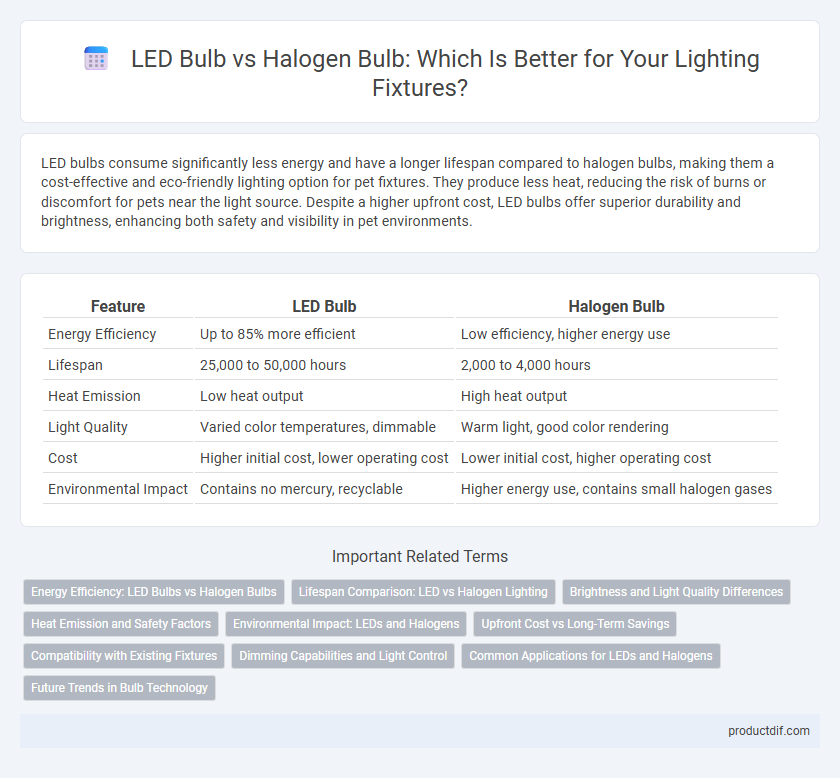LED bulbs consume significantly less energy and have a longer lifespan compared to halogen bulbs, making them a cost-effective and eco-friendly lighting option for pet fixtures. They produce less heat, reducing the risk of burns or discomfort for pets near the light source. Despite a higher upfront cost, LED bulbs offer superior durability and brightness, enhancing both safety and visibility in pet environments.
Table of Comparison
| Feature | LED Bulb | Halogen Bulb |
|---|---|---|
| Energy Efficiency | Up to 85% more efficient | Low efficiency, higher energy use |
| Lifespan | 25,000 to 50,000 hours | 2,000 to 4,000 hours |
| Heat Emission | Low heat output | High heat output |
| Light Quality | Varied color temperatures, dimmable | Warm light, good color rendering |
| Cost | Higher initial cost, lower operating cost | Lower initial cost, higher operating cost |
| Environmental Impact | Contains no mercury, recyclable | Higher energy use, contains small halogen gases |
Energy Efficiency: LED Bulbs vs Halogen Bulbs
LED bulbs consume up to 80% less energy than halogen bulbs while providing the same level of brightness, making them significantly more energy-efficient. The long lifespan of LED bulbs, averaging 25,000 to 50,000 hours, further reduces overall energy consumption by minimizing replacement frequency. Halogen bulbs, by contrast, typically last about 2,000 hours and convert more energy into heat, leading to higher electricity usage and wasted power.
Lifespan Comparison: LED vs Halogen Lighting
LED bulbs typically offer a lifespan of 25,000 to 50,000 hours, significantly outlasting halogen bulbs, which average around 2,000 to 4,000 hours. This substantial difference in longevity results in reduced replacement frequency and lower maintenance costs for LED lighting. The enhanced durability and efficiency of LED technology make it a more sustainable and cost-effective lighting solution compared to halogen fixtures.
Brightness and Light Quality Differences
LED bulbs offer higher brightness levels measured in lumens per watt, producing more light with less energy compared to halogen bulbs. The light quality of LED bulbs tends to be more consistent with adjustable color temperatures, providing options from warm to cool white, while halogen bulbs emit a warm, natural light with excellent color rendering but less versatility. LED technology achieves longer lifespan and reduced heat emission, enhancing overall lighting efficiency beyond the traditional halogen performance.
Heat Emission and Safety Factors
LED bulbs emit significantly less heat compared to halogen bulbs, making them safer for use in enclosed fixtures and reducing the risk of burns or fire hazards. Halogen bulbs operate at much higher temperatures, posing increased safety concerns, particularly in areas with flammable materials or close human contact. Choosing LED technology enhances energy efficiency while minimizing heat-related safety risks in residential and commercial lighting applications.
Environmental Impact: LEDs and Halogens
LED bulbs consume up to 80% less energy than halogen bulbs, significantly reducing carbon emissions over their lifespan. Halogen bulbs generate more heat, leading to higher energy consumption and increased environmental impact due to inefficient power use. The longer lifespan of LED bulbs also decreases waste and resource extraction compared to the shorter-lasting halogen alternatives.
Upfront Cost vs Long-Term Savings
LED bulbs have a higher upfront cost compared to halogen bulbs, often priced two to three times more per unit. Despite the initial expense, LED bulbs offer significant long-term savings through drastically lower energy consumption, using up to 75% less electricity than halogen bulbs. The extended lifespan of LED bulbs, averaging 25,000 to 50,000 hours as opposed to halogen's 2,000 to 4,000 hours, further reduces replacement frequency and maintenance costs, making LEDs more cost-effective over time.
Compatibility with Existing Fixtures
LED bulbs offer broad compatibility with most existing lighting fixtures due to their standard base sizes and lower heat output, reducing the risk of damage to older fixtures. Halogen bulbs, while also compatible with many traditional fixtures, often require specific voltage and heat-resistant materials to avoid fixture degradation. Choosing LED technology ensures seamless retrofit in fixtures designed for incandescent or halogen bulbs without the need for additional modifications or upgrades.
Dimming Capabilities and Light Control
LED bulbs offer superior dimming capabilities compared to halogen bulbs, providing a wider range of brightness levels with minimal flicker. Advanced LED dimmers enable precise light control, enhancing energy efficiency and extending bulb lifespan. In contrast, halogen bulbs typically have limited dimming ranges and generate more heat, reducing their suitability for sensitive lighting setups.
Common Applications for LEDs and Halogens
LED bulbs are widely used in residential lighting, commercial spaces, and streetlights due to their energy efficiency, long lifespan, and versatility in color temperature. Halogen bulbs are preferred in applications requiring bright, focused light such as task lighting, automotive headlights, and stage lighting because of their excellent color rendering and immediate full brightness. Both types serve distinct roles: LEDs dominate general ambient and decorative lighting, while halogens excel in areas demanding intense, precise illumination.
Future Trends in Bulb Technology
LED bulbs dominate future lighting trends due to their superior energy efficiency, longer lifespan, and decreasing manufacturing costs compared to halogen bulbs. Innovations like smart LED technology, tunable white lighting, and integrated IoT capabilities are driving the transition away from traditional halogen bulbs. The shift toward sustainable, low-power lighting solutions aligns with global energy regulations and consumer demand for eco-friendly options.
LED Bulb vs Halogen Bulb Infographic

 productdif.com
productdif.com